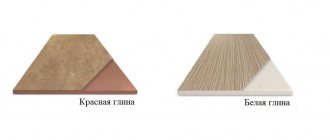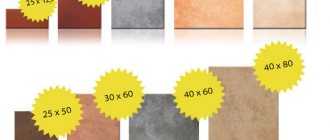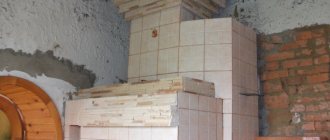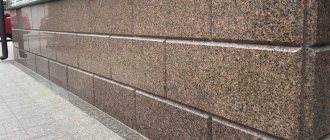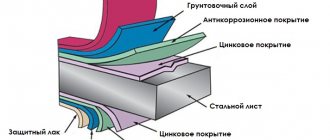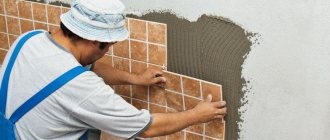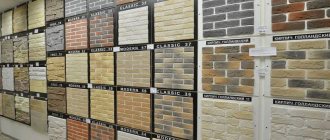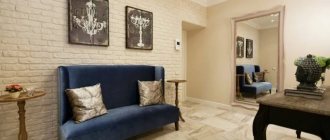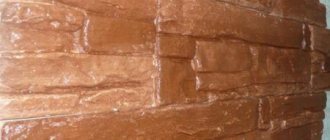Types of ceramic tiles
The raw materials for making ceramic tiles include red or white clay. At the same time, white clay tiles are more durable and durable.
Based on strength and appearance, ceramic tiles are divided into several varieties:
Pressure glazed
This is a ceramic tile familiar to many. A layer of liquid glass glaze applied to a dense, low-porous surface gives the tile an aesthetic shine and attractive appearance and increases its resistance to damage. Used in cladding walls and floors. There is a wide selection of this material on sale with translucent or opaque enamel of glossy, matte and embossed texture. The range also includes floor collections with anti-slip surfaces. In the range of these tiles, a special place is occupied by small-sized mosaic elements for creating floor compositions and wall panels.
Double fired tiles (Bikotura)
As a result of double firing technology, the tiles acquire a perfectly smooth texture and an almost mirror-like gloss. During the repeated firing operation, performed after the first glaze, fine bubble pores are eliminated from the clay structure and it is given ideal dimensions. During the reglazing process, the surface of the tile is decorated with prints. Widely used in wall and floor cladding.
Clinker tiles
This material, due to the peculiarities of manufacturing technology, is produced with an uneven edge. It is used for finishing floors, walls, and fireplace groups. The surface, which is heterogeneous in texture, can imitate brickwork, natural stone or wood.
Glazed or unglazed, it gives the interior a noble or extravagant aristocratic aesthetic. Using clinker tiles in the interior, you can easily create design elements in the styles of “loft”, “country”, “neo-Gothic”, “minimalism” and of course “high-tech”.
Cotto tile
A characteristic feature of such tiles is the uneven texture of the surface and edges. In most cases it has natural shades.
The application of enamel prints and engravings on its surface is carried out only by hand or by drawing. The emphatically individual design of each collection of Cotto tiles fits perfectly into interiors of ethnic and rural styles. These tiles are widely used for flooring.
Porcelain tiles
Due to the high level of its strength characteristics, it cannot be replaced in high-traffic areas. For interior decoration of residential buildings, it is often used in large areas (halls, guest areas).
The front surface of porcelain tiles for residential premises can have a matte or perfectly polished mirror-glossy texture. Such material, as a rule, has larger sizes, up to large-format, and is available for both seam and seamless installation.
Ceramic tiles come in a variety of shades and prints, including photo printing, and pair well with borders and decorative elements.
We buy tiles: what is worth knowing
When purchasing tiles, it is good to purchase 10-20 percent more of it than we calculated after carefully measuring the coverage area in order to provide for any losses. Even if you later purchase the same type, the color may not be exactly the same and may vary from batch to batch.
The fewer seams, the interior will appear visually larger, and therefore, for such an effect we will need large tiles. The most fashionable options have a size of 70x70 cm; they can visually expand a small room. You should pay special attention to the decors; they are not found in every line; they are often used in the design of bathrooms and toilets.
In general, such a coating is indispensable in a modern apartment, especially for the bath and toilet. The invention of tiles by man can be considered a big step in the production of goods to improve our comfort. Modern solutions make it possible to create wonderful interior compositions using this material, including imitation of natural materials and the creation of all kinds of stylizations.
The choice of a specific type of ceramic tile depends on the type of room where we will use it and the operating conditions. We should not neglect the correct selection of technical characteristics for the sake of aesthetic properties, as this can soon lead to damage, cracking, abrasion and loss of the effect that we were trying to achieve.
Characteristics of ceramic tiles
Any finishing material is characterized, first of all, by mechanical strength. For ceramic tiles, this criterion is complex and includes the following parameters:
Wear resistance class
- PEI 1 - bathrooms and sleeping areas;
- PEI 2 - for sleeping areas, bathrooms, guest rooms, loggias;
- PEI 3 - for kitchen areas, hallways and balconies.
- PEI 4 - for premises with medium-high traffic, for example, front entrances, trading floors, offices.
- PEI 5 - for high traffic areas, such as shopping centers and airports.
Of the five wear resistance classes, the first 3 classes are optimal for an apartment
Moisture absorption and frost resistance
The type of tile molding is indicated by the letters A - extrusion, B - pressing.
- AI and BI - frost-resistant, with moisture absorption up to 3% (for outdoor use or use in rooms with high moisture levels);
- AIIa and BIIa - medium frost-resistant, with moisture absorption up to 3-6%;
- AIIb and BIIb - medium frost-resistant, with moisture absorption up to 6-10%;
- AIII and BIII - only for indoor cladding, with moisture absorption more than 10%;
For bathrooms, kitchen areas, loggias or balconies - AI, BI or AII and BII, and for corridors, guest and sleeping areas - AIII and BIII.
Chemical resistance
Of the five classes, “A” and “AA” are most suitable for finishing living space. For a bathroom you can take B or A, and for a combined bathroom - AA (the highest level of resistance).
Caliber
The caliber of the tile is an important indicator; it is indicated on the packaging in numbers from 0 to 5, or in dimensions in mm. When ceramic tiles are made, they are fired, and each firing produces a different size. For example, a manufacturer wants to obtain tile dimensions of 40X60 cm, but as a result of firing, the resulting tile is 39.5X59.8 or 39.3X59.7. Then a special laser measures and sorts the tiles by size. All tiles, for example 39.3X59.3, are sorted with a value of 1, and 39.5X59.5 with a value of 2. Usually the difference between the calibers is 1 mm. The closest to the nominal size will receive 0, there are also values 1,2,3,4,5.
When purchasing ceramic tiles, be sure to look at the size indicator on the packaging; it must be the same for all tiles, otherwise it will create problems when laying them.
Surface hardness
The stability characteristics of the enamel surface of ceramic tiles (tested under test conditions by deliberate scratching with natural minerals) for an apartment should be in the range from 3 (calcite) to 9 (corundum).
Variety
The assortment of ceramic tiles is indicated by the percentage of defects (including scratches and microchips):
- No more than 5% - 1st grade, packaging is marked in red;
- From 5 to 25% - 2nd grade, packaging is marked in blue;
- Over 25% is grade 3, marked in green (as a rule, it is not supplied for sale through retail chains).
Advantages of ceramic tiles
Ceramic tiles are in great demand and widely used due to their inherent advantages:
- Antistatic. Ceramic tiles, due to their chemical composition and structure, prevent the accumulation of electrical charges and, in a dry state, do not serve as an electrical conductor.
- Fire safety. Ceramic tiles are included in the line of non-combustible materials. At high temperatures and in close proximity to an open flame, it does not ignite, does not collapse and does not emit toxic substances.
- Environmentally friendly. Ceramic tiles are harmless to humans and the natural environment due to the inclusion of natural components in their composition (sand, clay, spar, metal oxides).
- Biological stability. The structure and composition of the material do not contribute to the breeding of small insects, bacteria and other microorganisms on the surface of the tile.
- Waterproof. Ceramic tiles do not absorb moisture and prevent its passage to the materials of the structures themselves. Does not lose appearance when exposed to water.
- Good thermal conductivity. Ceramic tiles heat up in a short time and are ideal for finishing the surfaces of modern heating systems such as “warm floors”.
- High wear resistance . The surface layer of the tile is not destroyed by friction with abrasives and chemicals.
- Frost resistance. Ceramic tiles are suitable not only for decorating indoor spaces, but also for finishing facades, terraces, gazebos and balconies.
- Easy to clean. Cleaning the surface of ceramic tiles does not require the use of strong chemicals. Cleaning from grease and regular washing with plain warm water is enough.
Subtleties of choice
To correctly select ceramic cladding, you should pay attention to the batch number, tone and caliber of all purchased tiles, check each pack - sometimes they are quite different, which can spoil the overall appearance of the finish.
Before purchasing, you need to check the side edges, especially if you are going to lay the tiles on the wall in a seamless manner. To do this, lean the two elements end-to-end and look at the gap - the gap should be no more than 0.5 mm.
Light colors will increase the volume of the room, dark ones, on the contrary, will reduce it, but dirt is less visible on darker and grainier surfaces.
On reflective tiles, especially dark ones, scratches and small chips are very noticeable, even a dried drop of water leaves a mark on the gloss, and it is more visible on dark ones.
Choosing ceramic tiles
It is advisable to select ceramic tiles for a room not only in accordance with its purpose, but also in accordance with its dimensions. Small-sized tiles visually give a small room more volume, while large-sized tiles make a spacious room more compact.
Having chosen a certain collection, you need to visually verify the high quality of its appearance:
- The clay surface at the ends should be partially covered with glaze on the front surface.
- The front surface of the tile should not have depressions, smudges, cracks or other deformations.
- Applying the front side of one tile to the back side of another should ensure a tight seal. The presence of a gap between them indicates the concavity of the tiles.
- The edges of the tiles should form an angle of 90. Skewed edges will seriously complicate the laying of the tiles.
- Tiles from the same collection from different batches may have deviations in tone or size (caliber). The tone indicator is often indicated on the packaging in Latin letters.
- When determining the number of packages, you should be guided not only by the area, but also by the method of laying the material.
Crosses for tiles
Crosses for laying tiles have a thickness from 1 to 8 mm and different pitches. How to choose the optimal size? Here you need to be guided by two criteria: the presence of a chamfer and the geometry of the sides.
The larger the tile size, the wider the grout joint should be. Therefore, before selecting the crosses, you need to lay the tiles on the floor, set the optimal gap and select the crosses according to it.
To calculate the ideal thickness, you need to divide the size of the long side of the tile by 100.
Which ceramic tiles to choose for the floor
The flooring in an apartment suffers the most wear and tear. Therefore, when choosing ceramic floor tiles, first of all, preference is given to the following collections:
- wear resistance class not lower than PEI 3;
- maximum resistance of the coating to chemical environments (class “AA”);
- with moisture absorption up to 3%.
In addition, the floor covering should not slip. The ideal option is tiles with an anti-slip effect.
Having decided on the characteristics of the material, you need to select tiles from the collection, the design of which will successfully fit into the style of the interior. Due to the fact that glossy surfaces become dirty most easily when in constant contact with shoes, it is better to choose ceramics with a matte texture for floors with frequent traffic.
To make the floor surface look more original, it can be decorated with tiles that differ in shape or by shifting elements of the usual square shape relative to each other.
It is advisable to select the size of the tiles in proportion to the dimensions of the space. For small rooms it is worth giving preference to smaller tiles, and for spacious ones - to larger tiles, even large-format ones. In addition, collections with large prints will give spacious interiors an even greater effect of volume.
Dimensions
As you know, tiles can be used for walls and floors. Their dimensional characteristics are completely different.
Wall tiles can be square or rectangular.
- The square shape is characterized by the following dimensional lines in cm - 15×15, 10×10, 20×20;
- The rectangular standard is 20×30 cm, but also produced and in demand are 2.5×15, 7.5×15, 10×15, 10×20, 15×20, 15×22.5, 25×30, 25 ×33.3, 27.5×40, 15×90, 30×90.
The average weight of ceramic tiles for interior walls per 1 square meter is from 12 to 16 kg. For facades - from 15 to 20 kg.
The thickness of the wall tiles is from 4 to 9 mm.
Most often, square tiles measuring 30x30 cm are used for flooring.
But with all that, it has a wide range of sizes and shapes.
- Square: 4.8x4.8 cm, 10x10 cm, 15x15 cm, 20x20 cm, 25x25 cm, 32.7x32.7 cm, 33.3x33.3 cm, 40 ×40 cm, 50×50 cm, 60×60 cm, 70×70 cm and so on, up to 100×100;
- Rectangular: 10×20 cm, 15×20 cm, 15×30 cm, 20×30 cm, 20×40 cm, 30×40 cm, 30×60 cm;
- 4-sided - 7.5x17.3 cm, 8.5x19.6 cm, 10x23 cm;
- 5-sided: 9.8x17 cm, 11.5x20 cm;
- 6-sided: 15×17.3 cm, 17×19.6 cm, 20×23 cm;
- 3-angled: 5.8×8.3 cm, 68×97 cm, 83×118 cm, 98×139 cm;
- 8-sided - 6x8.5x17 cm, 7x10x20 cm.
The average weight of ceramic tiles for a regular floor is 15–25 kg per square meter. meter, for rooms with increased load - 70 kg.
The thickness of flooring materials depends on their type:
- Regular tiles - from 6 mm to 1.1 cm;
- Increased strength - 2.5 cm;
- Porcelain tiles - from 4 to 14 mm.
The bending strength properties of ceramic tiles depend on the thickness parameters.
Mosaic tiles have a dimensional line - 1x1 cm and 5x5 cm. Thickness - 2-4 mm.
Which tile to choose for the kitchen?
For the most part, in the food preparation area, ceramics are used as floor finishing, as an apron for the work area, and on the wall behind a furniture set with appliances.
For the apron of the work area, it is necessary to be guided by the criteria of moisture absorption and chemical resistance, since this element of the kitchen design is often in contact with condensate vapor and moisture.
Therefore, it is preferable to choose a material with a coating resistance class to chemical environments “AA” and moisture absorption up to 3%.
Ceramics for finishing the floor and apron must appear in a single stylistic ensemble with the rest of the interior elements. Their combination is acceptable both in shades of the same color and in contrasting ones.
When choosing a ceramic tile design for a backsplash, you must follow a number of rules:
- Tiles with a smooth glossy texture are superior to matte or textured ones in terms of ease of cleaning.
- The glossy surface is an excellent reflector of light, so tiles with such a surface can be considered an additional element of lighting for the kitchen interior.
- Tiles of natural light brown shades hide dirt better than others.
- White tiles will suit interior elements of any shade.
- To prevent a plain apron from seeming boring, it can be diluted with inserts with decorative patterns such as:
- panel;
- printed tile inserts;
- borders and friezes;
- pencil.
The design of the tiles used to decorate the part of the wall hidden behind the kitchen furniture can be absolutely anything. The main task of ceramic coating in this area is to ensure fire safety and hygiene of the surface.
Living room decoration - an unconventional solution
Since the operating conditions in this room do not require any extreme conditions, the main criterion when choosing a coating is its decorative qualities. In this room you can create a unique design by covering any specific area: dining room, relaxation area. Stone-look tiles are often used near the fireplace - the material is extremely resistant to temperature changes. Laying relief tiles on the wall allows you to create an interesting panel.
Glazed ceramic wall tiles are used in both the kitchen and bathroom. Matte tiles are most often used in residential premises.
Advice! Glossy tiles can give an effect similar to the use of mirror surfaces and can be used to model space. It can be used to decorate a long wall in a narrow room to avoid the feeling of a “pencil case”.
Wall decoration with ceramic tiles becomes “rich” in the presence of decors.
But they significantly increase the renovation budget, since they are sold individually. Lining niches in the walls with ceramic tiles and decorating door and window openings with them looks interesting. The finishing with textured tiles, which can have the most bizarre volumetric shapes and patterns, looks impressive. Such decoration, especially if done in bright colors, can play the role of the main element of the interior.
Which tile to choose for the bathroom?
Of all the rooms in the apartment, the bathroom, based on its purpose, is the wettest room. Therefore, here, ceramic tile cladding requires the floor, walls, as well as the outer surface of the bathtub or shower enclosure.
The tiles in this room, regardless of the surface being tiled, must have the highest moisture absorption class - up to 3%. At the same time, preferences for the style of bathroom design should not come at the expense of the strength characteristics of the selected material.
When choosing ceramic tiles for decorating this wet area of the apartment, you need to take into account the following recommendations:
- For the floor, it is more advisable to give preference to tiles with a matte texture in order to eliminate injuries from the danger of slipping.
- Tile with a deep relief texture for the floor should not be considered due to its active contamination.
- It is better to cladding the walls and outer surfaces of shower corners and bathtubs with ceramics with a glossy texture in order to reduce the time of contact with water and ensure ease of cleaning.
- For walls, it is more rational to choose tiles whose texture will not complicate its joining according to the relief and pattern.
- Bathroom walls decorated in dark colors make the room visually less voluminous.
- When choosing a color scheme, you should give preference to a light palette for the upper tier of the room and a dark one for the lower part of the walls with a transition to the design of the floor.
- It is better to abandon multi-colored material in favor of a combination of light and dark shades of a single color scheme, diluted with decorative elements.
Advantages of surface finishing
Wall cladding with ceramic tiles is appropriate even in the bedroom, thus creating the desired design of the room.
At the moment, there are many effective and practical materials, but ceramic tiles for walls, both internal and external, have a number of advantages:
- High strength and, accordingly, durability;
- Non-flammability and, as a result, no release of smoke and toxic compounds during a fire;
- Moisture resistance, giving immunity to the effects of atmospheric phenomena and high humidity in the premises;
- The cladding of internal walls with ceramics is practically impervious to wear;
- Frost resistance, which is especially important for finishing facades, balconies and unheated rooms;
- Easy to care for – in most cases, regular wiping with a damp sponge is sufficient;
- Ceramic wall tiles do not fade when exposed to ultraviolet radiation;
- Chemical resistance - it is impervious to acids, alkalis and other aggressive compounds;
- Interchangeability of elements - if a ceramic tile has come off the wall, it is easy to put another one in its place, provided there is leftover material, but there is no need to completely redo the coating.
The decorative component in ceramic wall tiles is dominant in the design of bathrooms.
Expensive brands of sanitary ware without such a design most often look rather poor. Disadvantages of finishing - preparing walls for ceramic tiles and installing them is quite labor-intensive. The disadvantages of tiling include high thermal conductivity, fragility of the material, as well as low sound insulation qualities.
Important! The thickness of ceramic wall tiles should be about 8 mm. Wall-mounted products, unlike floor-mounted ones, are marked on the packaging with a palm-shaped pictogram.
The thickness of ceramic wall tiles can be as shown in the photo.
You can experiment with thin material, but you need to understand that thin material is not many years old, and renovations in the room should be done in at least five years. The classic thickness of the tiles has been tested and can withstand any obstacles quite easily. But if you are an experimenter, then you can try. Don't forget to share your experience... Laying tiles can be done on concrete, brick, and plasterboard surfaces. The installation method is a sticker on the wall after it has been leveled and primed. The bathroom requires preliminary waterproofing. Tiles are installed on wooden walls after the mesh is attached to them with self-tapping screws.
Mistakes when choosing ceramic tiles
- To ensure that the floor surface does not slip and looks like new for a long time, it is better not to use a glossy texture for its finishing.
- Rooms with high humidity should not be finished with tiles with a frost resistance rating of more than 3%.
- In order for the surface of the floor or wall to look as complete as possible, the choice should be made in favor of tiles laid using seamless technology.
- To prevent the room from looking boring, you should avoid tiling it in the same color.
- The tiled surface should not be overloaded with many decorative elements.
- When calculating the number of tile packages, be sure to personally depict its layout to scale, choosing the optimal installation method, and reserve at least 10%.
- When grouting tile joints, it is better to choose a tone that is as close as possible to the tone of the tile itself.
Correctly chosen ceramic tiles can, without requiring repairs, protect the surfaces of structures from damage for decades and delight the owners of the premises with their attractive appearance.
Tile categories:
- Solid tiles include stone, terracotta, ceramic, slate, marble and terrazzo in a variety of colors and textures. Although it is more expensive and more difficult to install than soft, it will last a very long time. For example, the service life of terracotta is quite long, it even gets better over the years.
- Soft tiles, which are made using vinyl, linoleum and cork, are nicer and softer underfoot than hard ones and are not as expensive. These tiles are easy to lay and easy to care for. Coatings made from soft tiles are also quite wear-resistant, although not as much as those made from hard materials.
Cladding tiles can be used both indoors and outdoors. Based on the material from which they are made, they can be divided into the following types:
